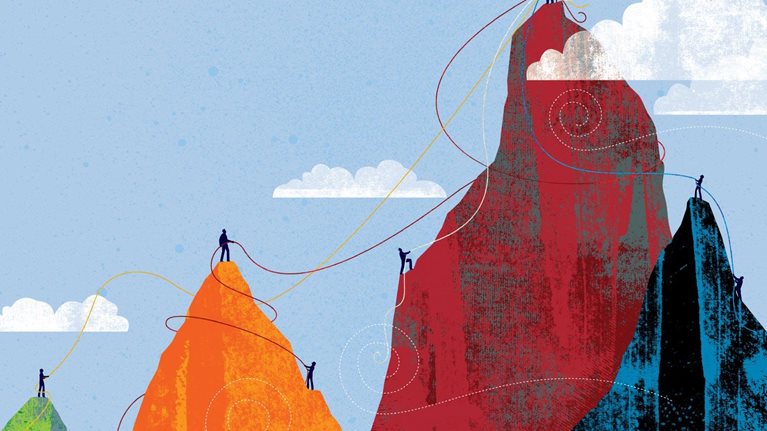The knowledge economy has not only spurred entirely new industries but also placed different demands on how people work effectively. In this video interview with McKinsey’s Rik Kirkland, Wharton School professor Adam Grant elaborates on his recent book, Give and Take: Why Helping Others Drives Our Success, which explores the evolving world of workplace dynamics, why selfishness fails, and how working with, for, and through others continues to be the recipe for personal and organizational success. An edited transcript of Grant’s remarks follows.
Interview transcript
Knowledge economy: Givers wanted
We’ve all observed that there’s a rise in project-based work, which corresponds with the knowledge economy—fewer dedicated jobs and long, stable careers and much more, “How do I combine a skill set with a need that you have?” And I think that as we see these kinds of shifts in the workplace, we’re going to see “giving” skills become more important, because a lot of getting work done then becomes about working with, for, and through other people.
All of these flattening structures, these ad hoc collaborations that require improvisation, are, at their core, about interdependence. And the data show that it’s in interdependent situations that givers thrive. So if you’re the kind of person who enjoys helping others, when you’re working in a team, you have the ability to make the team better and really multiply the team’s success in a way that, ideally, reverberates to benefit everyone in the team.
When you’re in a service job, your ability to serve customers is all about, “Can you identify their needs, anticipate new solutions for them, and then contribute those in a way that your customers feel is generous?” It might have been easier for takers to succeed in the old world, where you had these stable reporting hierarchies. And if they managed up effectively, then they were able to rise.
Today, in these structures, which are both flatter and more improvisational, I think that givers are going to find that their reputations start to take off, and that the people who are willing to support them, and champion them, are the people who respect them for their generosity.
Screening out the takers
The negative impact of a taker typically exceeds the positive impact of a giver by a multiple of two or three to one. You find that it’s pretty easy for one taker to be the bad apple that spoils the barrel. But when you put one giver in an organization, it’s not like one good egg will always make a dozen.
I’ve spent a good chunk of time in the past year working with organizations on mechanisms for screening out takers. And I think what’s powerful about that is, if you can eliminate takers from your organization, then you have givers and matchers. The givers will act more generously because they don’t have to be paranoid that takers are out to get them.
And the beauty of matchers, which is most people, is that they tend to follow the norm and reciprocate the way that they’ve been treated. So matchers act like givers in the presence of givers. They’re also useful for dealing with—if you have clients, for example, who are takers—matchers will fight fire with fire when they have to.
Then the question is, “How do you screen out takers?” And there are a couple ways to think about this. One way to screen out takers is to recognize that they follow a pattern of kissing up/kicking down. If you’re a taker, it’s quite important to be a good faker when you’re dealing with powerful people, because of course you want them to think well of you. But if you’ve never tried, it turns out to be a lot of work to pretend to care about every person you meet.
And takers tend to let their guard down a little bit when dealing with peers and subordinates, which means that you should be really skeptical of references that come from bosses. Lateral references and references from below are actually quite valuable.
There’s also evidence that takers, when they talk about success, tend to use two words more than the rest of us, which are “I” and “me.” And then, when they talk about failures, they tend to place blame externally. My favorite way of screening out takers is to present them with situational interviews.
A lot of organizations do behavioral interviews, where they’re backward looking and asking about your history, what you’ve accomplished, what challenges you’ve overcome. And those don’t turn out to be very effective if you look at the evidence, because they suffer from an apples-and-oranges problem: it’s very hard to compare two people’s work histories.
Instead, what you want to do is ask, “What would you do in a situation like this,” and give everybody the same situation. The problem is, no one wants to admit, “I would be a taker here.” But there’s an easy way around this, which is, instead of asking “What would you do?” you ask people to predict what other people would do.
Most of us tend to project our own motivations onto other people. If you give me a scenario where it’s not clear whether the appropriate behavior is giving, taking, or matching, what I’ll tend to do when predicting others’ behavior is ask, “Well, what would I do in this situation?” And then you get their honest opinion. Integrity-test research, for example, shows that the higher my estimate that other people will be thieves, the greater the odds that I myself am a thief.
Turning takers into givers
For me, the biggest unanswered question from Give and Take is, “What are the steps for turning a taker into a giver?” We know a lot about how to get takers to give in a particular moment. No one wants to be seen as a taker. If you can make behavior visible, takers tend to either match or give a little bit more.
We also know that takers tend to be more generous once they identify with an organization or a person. As they become attached to either you or to a group of people, then they start to blur the line between self-interest and concern for others, because, “If we’re identified with each other, then helping you or helping this organization is going to reflect positively on me.”
The problem is, when the taker switches—to a different relationship, a different group, a different organization—it’s like a reset button has been hit, and that person might go back to his or her old ways. So one of the things I’d love to explore next is, what does it require to shift a taker’s more fundamental mind-set and values?
It’s probably worth recognizing that there are different reasons that people fall into a taker pattern of behavior—and that we might need different strategies for influencing them, depending on whether they’re taking because they’re narcissists and they have very inflated but fragile egos, or if it’s a sense of scarcity and insecurity that leads them to feel they’ve got to claim everything for themselves.
On the other hand, is it that they used to be a giver or a matcher and got burned one too many times and learned the hard way that it’s dangerous to not be selfish? I’d love to investigate that a little bit more.
If you look at the data, what most employees are looking for in their jobs is a sense of meaning and purpose. And when you look at, in turn, what makes work meaningful, what enables people to feel that their daily lives in organizations are significant—more than anything else it’s the belief that “My work makes a difference.” That “What I do has some kind of benefit or lasting value to other people.” And I think this is something a lot of leaders overlook.
I spent a couple years studying call centers and asked leaders, “What would you do to motivate people who are working in very stressful, difficult jobs?” And the most common answers were, of course, the opposite of what we actually found worked.
A lot of employees were skeptical, especially in a call-center context, of “Does my work really do good? Or is my boss just trying to get me to work harder? There’s an ulterior motive there.” And what I found with a group of colleagues is that it’s effective to outsource inspiration—to find the customers, the clients, the end users who would benefit from your products and services, who can really speak firsthand to their impact.
And we got staggering results in the call-center setting when doing this. We bring in one person who’s benefited from the work that you do—to talk for five minutes about its impact—and we get over a 400 percent caller-by-caller spike in weekly productivity.
I think sometimes there is a tension between highlighting the mission and purpose behind work and measuring day-to-day performance. One of the challenges that we all face as leaders is also an opportunity to say, “What can we do to translate those day-to-day performance metrics into contributions toward the mission?” or into, “Here’s the way in which the purpose of this work is being fulfilled.”
An interesting example of this that comes to mind is at Merck, where we’ve had a number of conversations about the idea that many of the jobs, particularly if you’re doing sales, are hard to connect to—“What’s the real impact on patients?” But if you could translate the value of a drug into life-years saved, or quality-of-life contributed, it really shifts the meaning of the work, and now the performance measurements are less mundane.
It’s not easy to do, but I think in the next few years we’re going to see organizations start to innovate by coming up with mission-relevant metrics—as opposed to just standard performance evaluations.


